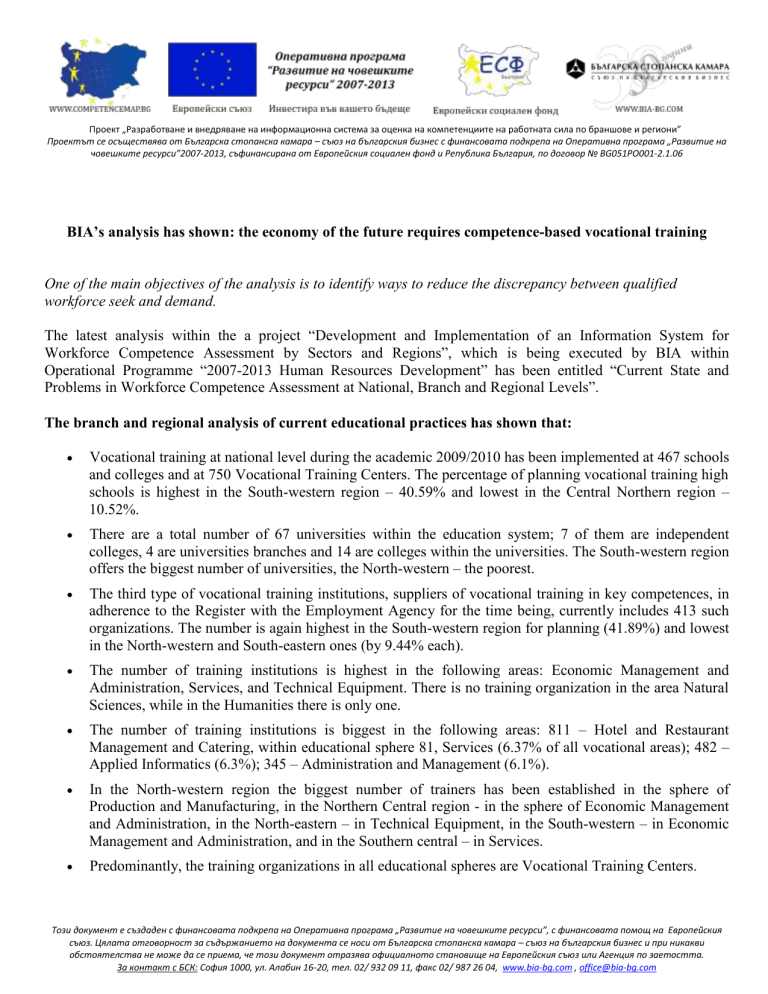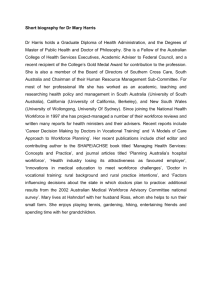BIA's analysis has shown: the economy of the future requires

Проект „Разработване и внедряване на информационна система за оценка на компетенциите на работната сила по браншове и региони”
Проектът се осъществява от Българска стопанска камара – съюз на българския бизнес с финансовата подкрепа на Оперативна програма „Развитие на човешките ресурси”2007-2013, съфинансирана от Европейския социален фонд и Република България, по договор № BG051PO001-2.1.06
BIA’s analysis has shown: the economy of the future requires competence-based vocational training
One of the main objectives of the analysis is to identify ways to reduce the discrepancy between qualified workforce seek and demand.
The latest analysis within the a project “Development and Implementation of an Information System for
Workforce Competence Assessment by Sectors and Regions”, which is being executed by BIA within
Operational Programme “2007-2013 Human Resources Development” has been entitled “Current State and
Problems in Workforce Competence Assessment at National, Branch and Regional Levels”.
The branch and regional analysis of current educational practices has shown that:
Vocational training at national level during the academic 2009/2010 has been implemented at 467 schools and colleges and at 750 Vocational Training Centers. The percentage of planning vocational training high schools is highest in the South-western region – 40.59% and lowest in the Central Northern region –
10.52%.
There are a total number of 67 universities within the education system; 7 of them are independent colleges, 4 are universities branches and 14 are colleges within the universities. The South-western region offers the biggest number of universities, the North-western – the poorest.
The third type of vocational training institutions, suppliers of vocational training in key competences, in adherence to the Register with the Employment Agency for the time being, currently includes 413 such organizations. The number is again highest in the South-western region for planning (41.89%) and lowest in the North-western and South-eastern ones (by 9.44% each).
The number of training institutions is highest in the following areas: Economic Management and
Administration, Services, and Technical Equipment. There is no training organization in the area Natural
Sciences, while in the Humanities there is only one.
The number of training institutions is biggest in the following areas: 811 – Hotel and Restaurant
Management and Catering, within educational sphere 81, Services (6.37% of all vocational areas); 482 –
Applied Informatics (6.3%); 345 – Administration and Management (6.1%).
In the North-western region the biggest number of trainers has been established in the sphere of
Production and Manufacturing, in the Northern Central region - in the sphere of Economic Management and Administration, in the North-eastern – in Technical Equipment, in the South-western – in Economic
Management and Administration, and in the Southern central – in Services.
Predominantly, the training organizations in all educational spheres are Vocational Training Centers.
Този документ е създаден с финансовата подкрепа на Оперативна програма „Развитие на човешките ресурси”, с финансовата помощ на Европейския съюз. Цялата отговорност за съдържанието на документа се носи от Българска стопанска камара – съюз на българския бизнес и при никакви обстоятелства не може да се приема, че този документ отразява официалното становище на Европейския съюз или Агенция по заетостта.
За контакт с БСК: София 1000, ул. Алабин 16-20, тел. 02/ 932 09 11, факс 02/ 987 26 04, www.bia-bg.com
, office@bia-bg.com
Проект „Разработване и внедряване на информационна система за оценка на компетенциите на работната сила по браншове и региони”
Проектът се осъществява от Българска стопанска камара – съюз на българския бизнес с финансовата подкрепа на Оперативна програма „Развитие на човешките ресурси”2007-2013, съфинансирана от Европейския социален фонд и Република България, по договор № BG051PO001-2.1.06
Major conclusions and inferences in the analysis:
1.
The drastic decline of qualified workforce is a serious issue, which hampers the development and functioning of whole economic sectors, as well as social spheres;
2.
The requirements, which the present vocational training currently faces, have undergone a change;
3.
The real need for vocational training in different occupations and majors should be defined;
4.
There is a lack of objective and up-to-date information about the labour market demands and tendencies;
5.
Workforce competence should be carefully and actively fostered and enhanced;
6.
The system for workforce assessment and development should be more thoroughly applied;
7.
There is a lack of existing vocational standards or competence models (competence profiles) which are in close adherence to the real practice;
8.
The employers should take part in the development of the particular curricula so that a compliance of the workforce qualified profile and the real labour market demand can be obtained;
9.
The development of an Information System for Workforce Competence Assessment will foster greater balance between the qualified workforce demand and supply, improve labour resource quality and mobility, enhance education attractiveness; hence, the employment possibilities and career prospects;
The development and introduction of an integrated information system for competence assessment by sectors and regions, as well as the establishment of a national data base which shall take into consideration the current state, requirements and changes of the national and European qualification requirements and standards, will help reduce the qualified workforce deficit, improve workforce quality and mobility, enhance education attractiveness, as well as employment possibilities and career prospects for the young people. Better forecast of the workforce demand (both by quantity and quality) shall improve the ability to meet labour market needs and shall help reduce the discrepancy between workforce demand and supply.
***
As a result from the analysis and the conclusions drawn, the following proposals for amendments in the current legislation have been made:
1.
The list of occupations, subject to vocational training should be updated once every two years, after the respective ministries and employers organizations have issued necessary proposals;
2.
A national system to guarantee the vocational training quality should be set up;
3.
A system for competence assessment independent from the training should be introduced;
4.
Prerequisites necessary for applying a credit point system, which establishes, accumulates, and transfers learning-acquired results, should be established;
5.
Well-balanced terminology should be introduced with respect to the third educational form - the informal one;
2/3
Проект „Разработване и внедряване на информационна система за оценка на компетенциите на работната сила по браншове и региони”
Проектът се осъществява от Българска стопанска камара – съюз на българския бизнес с финансовата подкрепа на Оперативна програма „Развитие на човешките ресурси”2007-2013, съфинансирана от Европейския социален фонд и Република България, по договор № BG051PO001-2.1.06
6.
A system for educational experience validation should be introduced;
3/3










